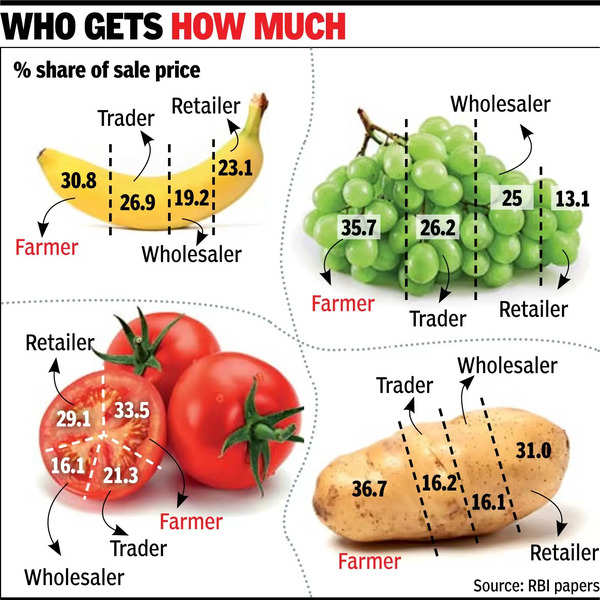MUMBAI: Indian farmers are getting only about one-third of the final selling price of fruits and vegetables, while a majority share is skimmed away by wholesalers and retailers, a series of research papers published by RBI on food inflation has showed. This is in contrast to other sectors, such as dairy, where farmers receive around 70% of the final price.
Egg producers seem to be best placed, getting 75% of the final price, while for poultry meat, farmers and aggregators together account for 56% of the price.
While consumers fret about tomato, onion and potato (TOP) prices at least twice a year as prices soar on seasonal factors such as excess or deficient rains or high or low temperatures, it is not as farmers are benefiting. The papers estimated that farmers receive approximately 33% of the consumer price for tomatoes, 36% for onions, and 37% for potatoes.

The report also provides figures for fruits, estimating that farmers receive 31% of the final price for bananas, 35% for grapes, and 43% for mangoes in the domestic market. In the export market, while the share for mangoes increases, the share for grapes drops, even though the overall price is higher.
The study, co-authored by agriculture economist Ashok Gulati, also concludes that forecasting price spikes is possible through a “balance sheet approach”. The papers also suggest various ways in which policymakers can smooth out these price spikes.
To prevent price spikes in TOP, the study recommended expanding private mandis, leveraging e-NAM, promoting farmer collectives, and relaunching futures trading. It also suggests building more cold storage facilities, promoting solar-powered storage, increasing processing capacity, and raising consumer awareness on processed TOP products. Additionally, improving productivity through better crop varieties and polyhouse tomato farming has been recommended to ensure stable supply and prices.
By forecasting the likelihood of a price spike, the research indicates that prices can be stabilised by short-term measures like adjusting trade policies to manage imports and exports based on supply-demand conditions. In the long term, it recommends improving productivity through innovation, better storage, and collective farming to increase farmers’ earnings. Enhancing the efficiency of the marketing system, integrating digital platforms like e-NAM, and improving processing technologies are also key to ensuring better price stability and transparency. For milk, poultry meat, and egg prices, it also recommends creating a feed bank to store and supply affordable fodder, utilising barren lands for grass cultivation, and promoting artificial insemination and disease control to increase livestock productivity.
For fruits, similar recommendations include improving the supply chain with better storage and transport, promoting different fruit varieties, offering crop insurance, expanding processing and exports, adjusting import duties to match demand, and using digital tools to track supply and reduce price swings.
